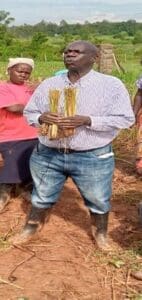
My name is Caleb Omolo from Kenya. I am an environmentalist and farmer, and have been using Vetiver grass since 2009. l have learned that the heat waves, droughts, floods, wild fires and dust storms are man-made and it is possible to turn the these extreme weather patterns around if we study the way nature works by embracing regenerative farming systems. I work with Vetiver grass as pioneer grass to help me create sustainable nature related farms.
I was introduced to Vetiver grass by Elise Pinners (TVNI) in 2009. Farms in Rongo (Kisii County – western Kenya), including my ancestral land, were very degraded. I started using vetiver grass to solve the soil erosion and wind erosion problems on my land. For the last 13 years I have learned so many other uses of vetiver grass in its relation to soil, and the functions of the vetiver roots and leaves that build soil organic carbon and improve soil moisture, as well as its role in enhancing the development of soil fungi and bacteria especially in the creation of food forests from degraded land. (see video of my food forest).
I learned that vetiver helps to change soil biology by enhancing the dominance of fungi over bacteria under forest conditions. I also learnt that once the forest has reached maturity, the fungi start working against vetiver. I have also learned that vetiver is eventually shaded out by tree growth and denser leaf canopy, the mycorrhiza turn their attention from the dying vetiver to the trees, supplying them with nutrients. This interaction between vetiver and other plants, as well as trees, is important, and should be a key component of regenerative agriculture. This is supported by Balaban (2005) “…. the hypothesis about the key role of the AMF in the coexistence of grass and trees. Their ERM (Extra Radicle Mycelium) links are important in the below ground interaction of plants and may change the output of the interaction. We suggest that the nutrient (P) transport can be realised via ERM, and the biological significance of such nutrient transfer between species could play an important role in harsh environments where the nutrient availability is a limiting factor for plant competition ability and survival. In conclusion, the interaction between grass and studied tree species mediated by ERM represents an important mechanism of plant coexistence affected by the symbiotic relationship with mycorrhizal fungi”
Regenerative farming is a farming system which has been practiced in many parts of the world. The Europeans and Americans learned it from Asian countries. The name “Regenerative Farming” was coined by Gerome Rodale in the 1930s. In Asia it is called “natural farming”. Many farmers in India, Japan and South Korea are practicing regenerative farming. Regenerative farming is a farming system that is cheap to implement because it uses locally available bio-degradable materials (mainly plant residues), that most farmers see as a problem, recycling them back into the soil.
Regenerative farming is able to turn bio-degradable waste into productive plant-based nutrients that in turn helps to increase crop yield, in contrast to synthetic conventional farming which has high input and lowering yields in the long term. Regenerative farming is able to maintain and often increase farm net incomes due to reduced expenses in input and labor (particularly weeding). What used to be seen as waste is, under regenerative farming, transformed into bio-complete compost, rich in plant nutrients that do no harm to the environment.
The object is to mimic nature in the way forest system works where all the elements are balanced enabling farmers multiple benefits through bio-diversity. Plant nutrients are plentiful but mostly unavailable, especially phosphorous, as well as potassium, calcium and iron. Regenerative farming, through enhanced fungal activity, enables these nutrients to be available to plants.
The most effective plant to enable the “mining” of these minerals is vetiver grass together with other cover crops that in a regenerative system are found in early stages of forest formation. They are known as pioneer plants or cover crops.
Vetiver, working with microbes, converts, through photosynthesis, atmospheric carbon dioxide to carbohydrates, feeding mycorrhizal fungi with carbon that in return produces an enzyme that breaks the bonds of different minerals making them available to plants. As the vetiver root goes deeper, mycorrhizal fungi continue feeding the roots with the nutrients while leaves and stem feeds with carbon. The process is called photosynthesis.
We have been working with farmers using vetiver grass in all types of soil, including degraded land, and we came to the same conclusion of its ability to build soil and develop available nutrients to plants. This system is environmentally friendly and is entirely organic with no dependence on agrochemicals.
In conclusion I encourage small scale marginalized farmers, such as the group I am working with in Lela, Siaya County – Kenya, to embrace “Regenerative Farming with Vetiver (RAV) because it is low cost and yields high returns, with minimum risk compared to conventional farming where fertilizer and other chemicals are very expensive for the average small farmer.
Vetiver grass is the right strategy to heal our land. The strategy is worth learning and practicing in Turkana with a lot in degradation. I will find this man Caleb to learn about this magical grass our solution.